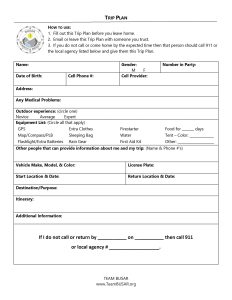
Great Smoky Mountains National Park offers hundreds of miles of backcountry trails perfect for summer walks in the woods. This is the second in a two-part series on ways to stay safe while hiking these paths during the summertime.
There are common scenarios hikers might face during the summer months: storms, ticks, and heat, to name a few. Preparing for these can help keep you safe as you explore all the beauty and wonder the Smokies have to offer.
In my previous article, I covered tips for minimizing the risks thunderstorms and water can present during these months. Below, I’ll dig into some considerations concerning wildlife and getting lost, as well as offer additional resources to help you prepare.

Wildlife
Stay a safe distance from any wild animal and a minimum of 50 yards (or half a football field) from large mammals like black bear, elk, and wild hogs. If you encounter any of these animals while on the trail, stand still, enjoy the moment, and move quietly away in the opposite direction until it is safe to proceed.
If you encounter a bear that’s aware of you, back away slowly and wait for the bear to leave. If the bear proceeds to move closer to you, do not turn and run away—you won’t win that race, and it could trigger a chase response. Instead, make lots of noise and try to make yourself appear larger. You can try stepping onto a rise beside the trail or waving hiking poles above your head.
The two venomous snake species in the park, northern copperheads and timber rattlesnakes, are not lying in wait alongside the trail to bite you. In fact, they would rather not bite you at all. Give them a wide berth and do not pick them up with anything to move them. It should give you solace that no one has ever died from a venomous snakebite in the park.
Ticks aren’t the first species most people think of when they consider dangerous animals in the park; however, they are tiny but mighty with the disease risk they pose, which is transmitted as they feed on your blood. Wear a repellent such as Sawyer Picaridin Lotion on your skin before heading out. You can even purchase clothing that is factory impregnated with permethrin or apply it to your existing clothing with a spray-on product. Most tick-borne diseases take over 24 hours to transmit to their host, so check yourself and your hiking partners at day’s end and remove any ticks promptly.

Getting Lost
Great Smoky Mountains National Park has over 800 miles of hiking trails. Each trail junction has a large sign denoting the trail name and any connecting trails, along with distances in mileage to the next junction. Carrying a map and referencing these trail signs as you hike is one of the easiest ways to prevent becoming lost.
“The national park’s search and rescue crews respond to about 100 incidents per year, many of them involving individuals who have become lost or incapacitated in the park’s backcountry,” said David Brill, author of Into the Mist: Tales of Death and Disaster, Mishaps and Misdeeds, Misfortune and Mayhem in Great Smoky Mountains National Park. “While injuries account for some of the rescue operations, others—perhaps the majority—result from failure to properly train, plan, and prepare and, thus, are largely preventable.”
 If you become lost, the best thing you can do is stop and wait for help. The Boy Scouts of America are taught to “hug a tree” if they become lost, and it’s wise counsel. This recommendation translates to stopping and staying put versus continuing to wander in hopes of finding your way out, which in many cases, will make things worse. If you have cell reception, call 911; however, do not wander farther seeking a spot of reception if you don’t have it, especially off the trail.
If you become lost, the best thing you can do is stop and wait for help. The Boy Scouts of America are taught to “hug a tree” if they become lost, and it’s wise counsel. This recommendation translates to stopping and staying put versus continuing to wander in hopes of finding your way out, which in many cases, will make things worse. If you have cell reception, call 911; however, do not wander farther seeking a spot of reception if you don’t have it, especially off the trail.
Keeping Safe on Your Summer Hikes
This trip planning worksheet created by Backcountry Unit Search and Rescue, a search and rescue team that works in the park, is something you should print and fill out before every hike. If you do not return home as planned, it is invaluable information for emergency services and can lead to you being found much quicker.
For more information about hiking safely in the park, this article from GSMNP is an excellent resource. Also, if you’d like to read tales of search and rescue operations in the park, Into the Mist by David Brill and my book, Chasing the Smokies Moon.
If you missed it, check out part one of this series for some tips on thunderstorms and water.
Subscribe to get the latest posts sent to your email.
The Great Smokies Welcome Center is located on U.S. 321 in Townsend, TN, 2 miles from the west entrance to Great Smoky Mountains National Park. Visitors can get information about things to see and do in and around the national park and shop from a wide selection of books, gifts, and other Smokies merchandise. Daily, weekly, and annual parking tags for the national park are also available.